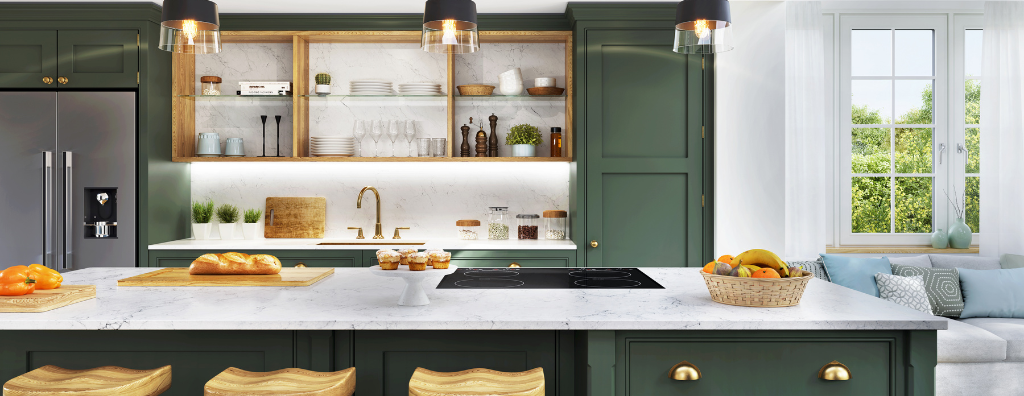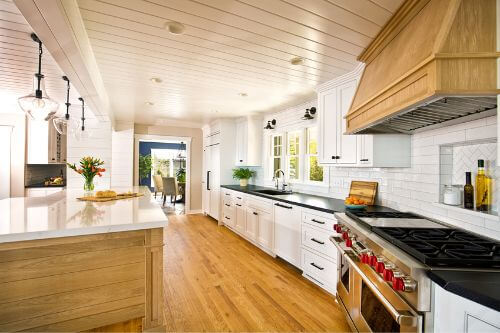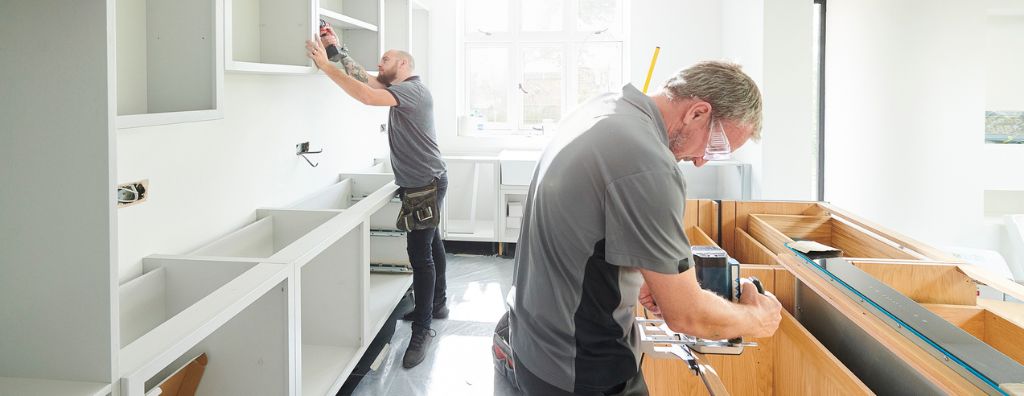Kitchen Remodel Must Haves

Many kitchen remodels are prompted by a desire for more storage, but there are plenty of reasons to want an upgrade. Whether your complaint is crowded counters, out-of-date appliances, or spending too much time cleaning up after a meal, there are ways to add functionality without sacrificing your aesthetic when you renovate your kitchen.
Storage
If you’re tired of finding expired food at the back of your lower cabinets or needing a step stool to reach items in the upper ones, roll-out cabinets and pantry shelves are a necessity. A roll-out garbage cabinet will keep trash and recycling cans out of sight (and smell). Be sure to use heavy-duty, reinforced hinges that can bear the weight of two, full cans.
Toasters, coffee makers, blenders, and air fryers can easily overcrowd kitchen counters. Appliance garages that hide away commonly used kitchen appliances now come in just about every configuration you can think of. If you love baking, you probably love your stand-up mixer even more. But moving it around can be a pain. Fortunately, installing a mixer riser into a lower cabinet is relatively simple and will put your favorite appliance right where you need it, only when you need it.
Cooking
Though some passionate cooks still swear by their gas ranges, induction cooktops have become all the rage for several good reasons. In addition to being easier to clean than gas stoves, induction cooktops are more efficient because all the heat they produce goes directly to your cookware rather than into the atmosphere of your home. And with inductor stoves, you never have to worry about dangerous fumes or open flames.
You don’t have to be an avid entertainer or the one who hosts Thanksgiving every year to reap the benefits from a double oven. Even cooking dinner for one or two people can be a challenge when you need to roast or bake things for different times or at different temperatures. A double oven fixes that, and it can improve efficiency if you prepare a dish using only the smaller oven since it takes less energy to heat up a smaller space. For extra user-friendliness, install the oven at counter height so you don’t have to bend over to pull out heavy dishes
Speaking of heavy… if your sink and cooktop are a bit distant from each other, a pot filler installed on the wall behind your stove could be a game changer. Say goodbye to heaving large pots of sloshing water across the kitchen!
For as long as microwaves have been around, people have wondered how to get them off their counters or make them appear more attractive. These days, microwave drawers are the new must-have kitchen upgrade. Instead of a door that swings open, the microwave is the entire drawer that slides out, and it can go in your kitchen island or along any cabinet wall.
Cleaning
Kitchen floors are notoriously difficult to keep clean. Between meal prep, quick snacks in front of the fridge, and near-constant traffic, crumbs and dust pile up quickly. If your home already has a central vacuum system, putting a vacuum slot in the kitchen makes clean ups a breeze. Simply sweep scraps into the slot—no more bending over with the dustpan. If you don’t have a central vacuum system, there are vacuum slot inserts on the market that use a traditional replaceable bag to collect what you sweep up.
If you’ve ever watched a mixologist or bartender shake up your cocktail and then place the shaker on top of a device that shoots up warm water to clean it, you’ve seen a glass rinser in action. Installing one in your own sink adds a touch of sophistication to your kitchen and makes cleaning glasses easier and more efficient, especially for those glasses that can’t go in the dishwasher or don’t fit on the top shelf.
It seems that a modern kitchen renovation isn’t complete until you’ve installed a large, single basin sink. There’s good reason for their increased popularity: more room to soak large dishes, easier to clean, etc. To really boost the usability of a single basin sink, consider adding hardware that makes it an efficient workstation. Drying racks, cutting boards, and colanders are readily available, easy to install, and will make your extra-large sink extra handy.
Remodeling Projects to Avoid When Selling Your Home

It’s common for homeowners to feel compelled to remodel their homes before they sell. Renovating the spaces in your home can increase its value and help you compete with comparable listings in your area. However, some remodeling projects are more beneficial than others as you prepare to sell your home. Always talk to your agent to determine which projects are most appealing to buyers in your area.
Remodeling Projects to Avoid When Selling Your Home
When preparing to sell your home, you want to strike the right balance of upgrades. Making repairs and executing renovations will attract buyer interest, but you don’t want to dump so much cash into remodeling that you won’t be able to recoup those expenses when your home sells.
So, how do you know where to focus your efforts? Your agent is a vital resource in understanding your specific situation and will offer guidance on your remodeling efforts to sell your home for the best price. Here are a few projects sellers will want to keep off their to-do lists for the best return on investment.

Image Source: Getty Images – Image Credit: skynesher
Minor Cosmetic Upgrades
Whether you’ve made small cosmetic upgrades throughout your home typically isn’t a make-or-break proposition for most buyers. Let’s say you’re questioning whether to invest in a new toilet, vanity, and shower for your primary bathroom before selling. Unless these appliances are damaged and you can repair them without spending too much, it’s okay to sell as is.
Major Upgrades with Long Timelines
For any remodeling project, your agent’s analysis will help you determine its risk/reward potential. This dynamic is heightened with major remodeling projects and home upgrades, due to their higher costs. Four of the six lowest ROI remodeling projects found in the Remodeling 2022 Cost vs. Value Report (www.costvsvalue.com)1 are upscale or major upgrades, all with roughly a 50% return on investment.
These projects come with hefty price tags and longer timelines than minor repairs and upgrades, which can complicate factors as you prepare to sell, especially if you have a deadline to get into your new home. They have the potential to temporarily displace you from the property, meaning you and your household may have to find somewhere else to stay until the project is complete.
- The Bottom Line: To go through with a major home upgrade before you sell, its schedule must fit with your moving timeline. It should also align with buyer interest in your local market. If the project doesn’t meet these criteria, it should be avoided.
Building Code Violations
The rules dictating whether you can sell your home with building code violations vary region to region. It also depends on what the building code violation is and whether neglecting to update it is deemed a safety hazard. The buyer’s mortgage lender may also have stipulations saying that the loan may not be used to purchase a home with certain features that aren’t up to code, which could lead to them backing out of the deal.
If you’re selling an older home, you’re not obligated to update every feature that may be out of code to fit modern standards. These projects are often structural and require a significant investment. If the violation in question was built to code according to the regulations at the time, then a grandfather clause typically applies. However, you’ll need to disclose these features to the buyer.
Trendy Makeovers and Upgrades
Lastly, it’s best to avoid remodeling projects that target a specific trend in home design. Trends come and go. Timeless design is a hallmark of marketable homes because it appeals to the widest possible pool of buyers. Keep this in mind when staging your home as well. Creating an environment that’s universally appealing and depersonalized allows buyers to more easily imagine the home as their own.
Learn more about remodeling your home as you prepare to sell here:
Should I Remodel or Sell My Home As Is?
1: © 2022 Zonda Media, a Delaware Corporation. Complete data from the Remodeling 2022 Cost vs. Value Report can be downloaded free at www.costvsvalue.com.
Featured Image Source: Getty Images – Image Credit: eclipse_images
High ROI Remodeling Projects to Increase Home Value

This blog post contains excerpts of the “Remodeling 2022 Cost vs. Value Report” (costvsvalue.com).1
As you prepare to sell your home, one of the major considerations you may face is whether to remodel, and if so, how to allocate your remodeling budget. Remodeling can help differentiate your home from competing listings in your area, but this competitive advantage comes at a price.
The following information provides insight on which remodeling projects deliver high ROI. To maximize the value of your remodel, talk to your agent about what buyers in your area are looking for and align your efforts accordingly.
High ROI Remodeling Projects to Increase Home Value
It’s no secret that buyers want to see a home with curb appeal and attractive interior spaces. But as a seller, you’ll only have so much budget to work with and you want to get the most return on your investment. As laid out below, here are the five highest ROI remodeling projects nationwide as found in the Remodeling 2022 Cost vs. Value Report (www.costvsvalue.com).1
|
Remodeling Project |
Cost of Remodeling Project (2022) |
Resale Value of Remodeling Project (2022) |
ROI |
|
Garage Door Replacement |
$4,041 |
$3,769 |
93.3% |
|
Manufactured Stone Veneer |
$11,066 |
$10,109 |
91.4% |
|
Minor Kitchen Remodel (Midrange) |
$28,279 |
$20,125 |
71.2% |
|
Siding Replacement (Fiber – Cement) |
$22,093 |
$15,090 |
68.3% |
|
Window Replacement (Vinyl) |
$20,482 |
$13,822 |
67.5% |
This data shows that for a given remodeling project a higher expenditure doesn’t necessarily equate to higher ROI. It’s interesting to note that only one indoor project—the minor kitchen remodel—placed in the Cost vs. Value Report’s top five.
Four of the Cost vs. Value Report’s bottom six entries are upscale remodeling projects, all with roughly a 50% average return on investment. The conclusion to be drawn here is that remodels of this magnitude are expensive and should be considered carefully before you greenlight them. The upside to these projects, though, is that they have a much higher resale value than a simple fresh coat of paint or a change in décor. If you and your agent identify a logical upscale remodel with serious resale potential whose costs you can handle, it can help you get the best price for your home.
So, does this mean you should replace your garage door before selling your home bar none? Not necessarily. Again, your remodeling priority list should target the areas of your home that need attention while aligning with local buyer interest. Your agent can provide guidance on what competing listings in your area are offering and refer you to trusted remodeling contractors in your area.

Image Source: Getty Images – Image Credit: YinYang
Budget-Friendly ROI Home Projects
Though smaller scale home makeovers don’t have the value-adding power of larger remodeling projects, they can still make a difference when selling your home.
Instead of an upscale kitchen remodel, you can focus more on making minor improvements in several areas. For example, repainting or refinishing your cabinets, swapping out your drawer pulls and hardware, and installing new appliances can make your kitchen feel brand new with a smaller budget. When remodeling your bathroom, tasks like refinishing your tub, installing new lighting, and a new backsplash can make a strong impression on buyers.
For more information on budget-friendly home makeovers with ROI potential, check out our quick guides to upgrading your bathrooms, bedrooms, home office, and kitchen.
- © 2022 Zonda Media, a Delaware Corporation. Complete data from the Remodeling 2022 Cost vs. Value Report can be downloaded free at costvsvalue.com.
Hiring a Contractor for Your Remodel

Much has been said about the benefits of taking a DIY approach to home remodeling projects. It instills pride of ownership, builds the sweat equity you’ve put into your home, and can be more affordable than hiring a professional. The reality is, however, that sometimes, projects simply require a pro to be done right. Whether it’s the magnitude of the project, the caliber of skill required to successfully complete the job, or a combination of the two, certain projects are best executed in the hands of a professional. So, what do you need to keep in mind when hiring a contractor? Here are some quick tips:
Preparing to Hire a Contractor
Have your plans ready when you begin meeting with contractors. This will show them that you are prepared and fully invested in the project. Conduct phone interviews and meet in-person with potential candidates to give yourself the opportunity to gauge their professionalism and expertise. Here are some helpful questions to ask to get you started:
- What prior experience do you have with this particular remodeling project?
- Is your company licensed?
- What is your timeline for starting and completing this job?
- How long have you worked with your current subcontractors?
- Could you provide a list of references that can speak to your quality of work?
Contractor Contracts and Implied Warranty
It is important that you understand the contract you’re agreeing to, and that you examine its finer points, such as the warranty terms. These terms will spell out what course of action will result should there be an issue with the contractor’s work. In the U.S., we have a legal concept known as “implied warranty” that protects those who hire out contractors. “Implied warranty” essentially means that it is understood that the contractor will perform quality work and that the home will continue to be safe to live in as a result of the repairs. These implied warranties are known as “good workmanship” and “habitability” respectively.
A good contract will have a detailed description of the labor and materials required to perform the job, a project schedule, the names of suppliers and subcontractors the contractors plan to use, and the payment schedule you have agreed upon.

Image Source: Getty Images – Image Credit: shynesher
Setting a Payment Schedule
When it comes to the cost of labor and materials, you won’t have much room for negotiation. The payment schedule, however, is one area where you can negotiate. Before the work begins, agree on a payment structure with your contractor. Good contractors want to perform high-quality work, completed on-time, and the agreement you reach together can incentivize their work. For example, you can stipulate that a certain percentage of the total job cost is paid out when certain stages of the project are completed.
The Potential for Temporary Housing
For large-scale remodeling projects, contractors need space to work at a high standard. Accordingly, it may be best for everyone involved if you and your household move out of your home temporarily until the work is complete. A home during a remodel is a noisy and chaotic place to be. Dust is flying, saws are buzzing, sheetrock is crashing to the floor, walls are being knocked out, and hammers are hammering. Trying to coexist with the remodel may be more trouble than it’s worth, since your usage of your home will be severely limited for the time being. If you plan on hiring a contractor to perform a large-scale remodel, search for housing alternatives far in advance to ensure that you and your household will have a place to stay.
For more information on remodeling your home, read our guide to remodeling your bathroom:
How Long Is Your Contractor Liable?

Constructing or remodeling a home is a complex, expensive endeavor. Ideally, everything goes as planned, and when the dust clears, the homeowner can settle in and enjoy the new home — and never think about the building process again.
 Facebook
Facebook
 X
X
 Pinterest
Pinterest
 Copy Link
Copy Link



